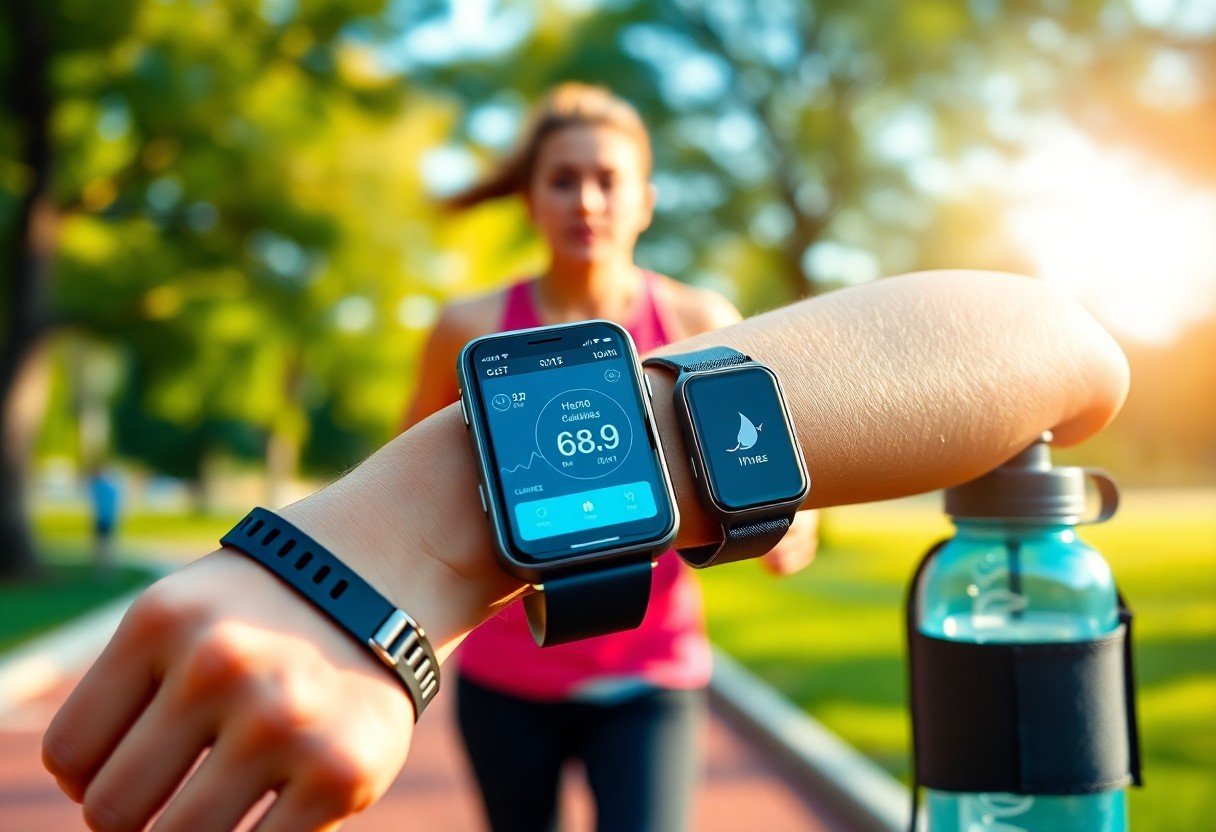There’s a revolution happening in the weight loss landscape, and it’s driven by wearable technology. Devices like fitness trackers and smartwatches enable you to monitor real-time data about your activity levels, heart rate, and sleep patterns. These insights empower you to make informed choices about your diet and exercise, ultimately supporting your weight loss journey. However, it’s necessary to approach these tools with a balanced perspective, as relying too heavily on tech can lead to unhealthy habits. Embrace this innovation to enhance your wellness, but maintain a holistic view of your health.

Key Takeaways:
- Wearable tech provides real-time tracking of physical activity and caloric intake, promoting accountability.
- Integration of health data from wearables enables personalized weight loss strategies based on individual progress.
- Social features in wearable technology foster community support, enhancing motivation and adherence to weight loss goals.
Understanding Wearable Technology
Definition of Wearable Technology
Wearable technology refers to electronic devices designed to be worn on the body, often incorporating sensors and software to collect data regarding your health, fitness, and daily activities. These devices seamlessly integrate into your lifestyle, providing real-time feedback and insights aimed at enhancing your personal wellness and fitness journey.
Types of Wearable Devices
Wearable devices come in various forms, each serving distinct purposes to assist with weight loss and fitness tracking. Common types include fitness trackers, smartwatches, smart clothing, head-mounted displays, and wearable medical devices. Each type not only tracks activity but can also monitor heart rate, calories burned, and even sleep patterns, making them valuable tools for achieving your health goals.
| Fitness Trackers | Monitor physical activity, steps, and calories burned. |
| Smartwatches | Offer fitness tracking alongside smartphone notifications. |
| Smart Clothing | Integrates sensors to track workouts and vital signs. |
| Head-Mounted Displays | Provide immersive experiences for workouts and games. |
| Wearable Medical Devices | Monitor specific health issues, often with alerts. |
The diversity of wearable devices makes it easier for you to find a solution that fits not only your fitness needs but also your personal style and lifestyle. For instance, a fitness tracker might be great for monitoring steps and heart rate during runs, while a smartwatch could keep you connected without interrupting your workout. This variety also means you can choose devices based on your specific health goals, whether it’s tracking workouts, monitoring sleep, or managing chronic health conditions. Knowing your preferences ensures you select the most effective technology to support your weight loss efforts.
- Choosing the right device for your needs is important.
- Features like heart rate monitoring can enhance tracking.
- Compatibility with apps increases functionality.
- Durability matters for active lifestyles.
- Price can vary greatly across devices.
| Activity Tracking | Detailing daily exercise and movement patterns. |
| Heart Rate Monitoring | Track your heart rate during exercise for better insight. |
| Sleep Tracking | Analyze sleep quality to improve recovery and health. |
| Caloric Tracking | Keep tabs on calories consumed versus burned. |
| Personalized Goals | Set and monitor progress toward your fitness objectives. |
The Science of Weight Loss
Caloric Deficit Explained
A caloric deficit occurs when you consume fewer calories than your body requires for maintenance. To lose weight, you need to create this deficit, typically by reducing caloric intake and increasing energy expenditure. The fundamental principle is straightforward: if you burn more calories than you eat, you will lose weight. Research shows that a deficit of approximately 3,500 calories results in a loss of about one pound of body weight.
The Role of Physical Activity
Your level of physical activity plays a significant role in creating a caloric deficit. Engaging in regular exercise not only burns calories but also boosts your metabolic rate, leading to greater fat loss. Incorporating both aerobic and strength training can maximize your results by increasing muscle mass, which in turn helps burn more calories at rest.
For instance, high-intensity interval training (HIIT) has shown effectiveness in accelerating weight loss compared to moderate exercise. Studies suggest that incorporating shorter, more intense workouts can lead to significant fat loss while saving time, making it easier to fit exercise into your busy schedule. Moreover, wearable tech can track your workouts and ensure you are meeting your physical activity goals.
Tracking Nutritional Intake
Monitoring your nutritional intake is imperative for effective weight loss. By keeping a record of what you consume, you gain insights into your eating habits and can identify areas for improvement. Many wearable devices or apps offer features that allow you to log meals, making it easier to maintain a caloric deficit while ensuring you’re getting the nutrients your body needs.
Utilizing tracking tools can reveal calorie-dense foods that may sabotage your efforts. Studies indicate that those who track their food intake can lose more weight over time compared to those who do not. By being mindful of portion sizes and nutritional value, you can make informed choices that contribute to your long-term weight management goals. For more on this, you can refer to research discussing how can weight loss be accelerated if we exercise smarter with…
How Wearable Tech Supports Weight Loss
Real-Time Data Monitoring
With wearable tech, you have access to real-time data monitoring that tracks your physical activity, heart rate, and even sleep patterns. This information helps you understand how your body responds to different workouts and lifestyle changes. By analyzing this data, you can make informed decisions about your diet and exercise routines, leading to more effective weight loss outcomes.
Personalized Fitness Goals
Wearable devices allow you to set personalized fitness goals based on your current fitness level and weight loss objectives. These tailored targets can include daily step counts, calorie burn, and workout durations. As you progress, your wearable can adjust these goals, ensuring they remain challenging yet achievable, which is crucial for consistent motivation and success.
Utilizing personalized fitness goals gives you a structured pathway toward weight loss. For example, devices analyze your previous activity levels and set attainable targets that encourage gradual improvements rather than overwhelming aspirations. This customization not only enhances your engagement but also increases the likelihood of meeting your objectives, fostering long-term commitment to your fitness journey.
Motivation through Gamification
Gamification in wearable tech leverages game-like elements to keep you motivated and engaged in your weight loss efforts. By incorporating challenges, rewards, and points systems, these devices make your fitness journey feel more like a game, pushing you to achieve personal bests and compete with others.
This approach to fitness creates a sense of achievement and community. As you earn badges or milestones for reaching your activity targets, the feeling of accomplishment drives you to maintain a consistent workout routine. You are encouraged not just to complete fitness tasks, but to enjoy the process while connecting with others who share similar goals, fostering both motivation and accountability.
Social Sharing and Challenges
Many wearable devices facilitate social sharing and challenges, which can enhance your weight loss journey. By sharing your accomplishments with friends or participating in community challenges, you create a support network that fuels your determination to stay on track.
Engaging in social challenges can be a powerful motivator. Competitions with friends or followers encourage accountability, as your progress is visible to others. The friendly rivalry often inspires you to push harder and remain committed to your fitness journey, transforming personal weight loss goals into shared experiences that foster encouragement and camaraderie.

Features of Effective Wearable Devices
Heart Rate Monitoring
Your heart rate is a key indicator of how your body responds to exercise and stress. Effective wearable devices provide real-time heart rate monitoring, enabling you to adjust your workouts for optimal fat burning and cardiovascular health. Many wearables use optical sensors to measure your heart rate continuously, allowing you to track your exertion levels during various activities.
Sleep Tracking
Quality sleep directly influences your weight loss efforts. Wearable devices equipped with sleep tracking functionality analyze your sleep patterns, providing insights into both quantity and quality. This information is vital, as insufficient sleep can hinder weight loss by affecting metabolism and hunger hormones.
When your device tracks sleep, it typically measures various stages: light sleep, deep sleep, and REM sleep. Understanding how much time you spend in each stage allows you to make adjustments in your routine. For instance, if you notice that you’re not getting enough deep sleep, you can focus on improving your sleep hygiene, such as reducing screen time before bed or creating a more restful sleeping environment.
Activity Tracking and Feedback
Activity tracking provides a comprehensive overview of your daily movement, including steps taken, distance traveled, and calories burned. Effective wearable devices offer instant feedback that motivates you to stay active throughout the day. By setting personalized goals, you can see your progress and make informed decisions to enhance your fitness regimen.
Additionally, many wearables encourage you to achieve specific activity goals through reminders and challenges, creating a sense of accountability. For example, receiving alerts to move after prolonged sitting or notifications for completing daily step targets can significantly boost your motivation and reinforce healthy habits.
Integration with Nutrition Apps
Integrating your wearable device with nutrition apps offers a more holistic approach to weight management. These integrations allow you to track caloric intake alongside your physical activity, giving you a clearer picture of your energy balance. By analyzing your dietary habits, you can make informed adjustments to your eating patterns that align with your fitness goals.
Utilizing apps like MyFitnessPal alongside your wearable device simplifies tracking by allowing you to log meals effortlessly. Some wearables even sync with these apps to provide real-time feedback on how your diet impacts your activity level, helping you stay within targeted caloric ranges to support effective weight loss strategies.

Case Studies and Success Stories
- Jennifer, 34: Used a smartwatch to track her daily steps, resulting in a loss of 25 pounds over six months.
- Michael, 42: Combined dietary apps with a fitness tracker, achieving a 40-pound weight loss in one year.
- Angela, 28: Participated in a wearable tech community challenge, leading to a 30% increase in her weekly activity levels and a loss of 15 pounds.
- David, 51: Monitored his caloric intake with a fitness tracker, losing 60 pounds over the course of eleven months.
- Emily, 30: Followed guided workouts on her fitness band, resulting in a 20-pound weight loss and improved energy levels.
Individuals Who Have Successfully Lost Weight
Many individuals have transformed their lives using wearable tech. For instance, Jennifer documented a loss of 25 pounds by consistently tracking her step count and physical activity through her smartwatch, showcasing how small, manageable changes can lead to significant shifts in weight management.
Insights from Health Experts
Health experts agree that wearable tech offers invaluable support in weight loss efforts. They emphasize the importance of setting achievable goals and leveraging data to enhance personal accountability, which significantly uplifts your chances of success over time.
Experts note that by integrating wearable technology into your daily routine, you can gain insights into your daily habits. For example, understanding your heart rate response during workouts informs better training decisions, while tracking sleep patterns aids in recovery and overall wellness. Such strategic data utilization is pivotal in fostering long-term lifestyle changes and adhering to weight loss goals.
Long-Term Benefits of Using Wearable Tech
Utilizing wearable tech doesn’t just facilitate initial weight loss; it significantly contributes to maintaining your achievements. By keeping you engaged and informed, these devices promote continuous healthy habits, reducing the likelihood of regaining weight.
Long-term users of wearable devices often report better overall health metrics, including lower blood pressure and improved metabolic conditions. With ongoing monitoring and feedback, your capacity for sustained weight management increases, making it easier for you to navigate lifestyle changes and stay motivated in the long run.
Challenges and Limitations
Over-Reliance on Technology
Your dependence on wearable tech can lead to a disconnection from intuitive eating and exercise habits. Many users might become too focused on metrics and data, neglecting the importance of listening to their own bodies. This shift can create unrealistic expectations and foster anxiety around physical activity and food, potentially undermining overall health and wellness.
Data Privacy Concerns
When you use wearable technology, you’re often sharing sensitive health information. This raises significant concerns about how your data is collected, stored, and used. The potential for unauthorized access or misuse of this information can make you hesitate to fully engage with these devices.
Most wearable tech devices collect extensive data, including heart rate, activity levels, and even sleep patterns. Companies may sell this information to third parties for marketing purposes, without your explicit consent. It’s necessary to be aware that not all manufacturers prioritize data security, thus compromising your privacy and increasing your vulnerability to data breaches or identity theft.
Accuracy of Tracking
The data you receive from wearables can sometimes be inaccurate, leading to misguided weight loss strategies. Factors like device calibration, body movement, and environmental conditions can significantly impact the accuracy of metrics such as calorie counts or step tracking.
Studies have shown that some wearables can have a margin of error of up to 20% in calorie estimates, which can lead you to overestimate or underestimate your actual physical activity. If you’re relying heavily on these metrics for weight loss, it’s vital to cross-reference with other methods or consult professionals to ensure you have a well-rounded view of your progress.
Conclusion
Considering all points, wearable technology is revolutionizing your weight loss journey by providing real-time data and personalized insights. These devices not only help you track physical activity and caloric intake but also motivate you to stay consistent with your goals. By integrating wearables into your routine, you gain a comprehensive understanding of your habits, making it easier to make informed decisions about your health. Embracing this technology empowers you to take control of your weight loss efforts effectively and sustainably.
FAQ
Q: How does wearable tech help track calorie expenditure?
A: Wearable devices monitor physical activity and calculate calorie burn by tracking heart rate, movement, and other metrics, providing users with accurate feedback on their daily energy expenditure.
Q: Can wearable devices provide personalized fitness recommendations?
A: Yes, many wearable tech products analyze user data to offer customized workout plans, suggest optimal activity levels, and adjust dietary recommendations based on individual goals.
Q: Do wearables assist in maintaining motivation for weight loss?
A: Wearable tech often includes features like progress tracking, reminders, and social sharing options, which can boost motivation by allowing users to visualize their achievements and connect with others.
Q: How do heart rate monitors in wearables contribute to weight loss?
A: Heart rate monitors provide real-time feedback on exercise intensity, helping users optimize their workouts for fat burning and ensuring they are training within their target heart rate zones.
Q: Are there any disadvantages to relying on wearable tech for weight loss?
A: While wearable tech offers numerous benefits, potential drawbacks include over-reliance on devices, inaccuracies in tracking, and the possibility of becoming discouraged by slow progress when using them as the sole measure of success.









